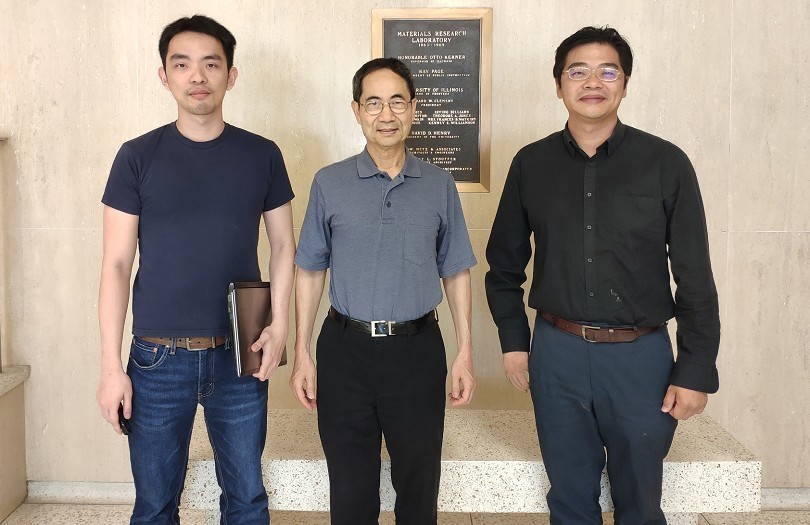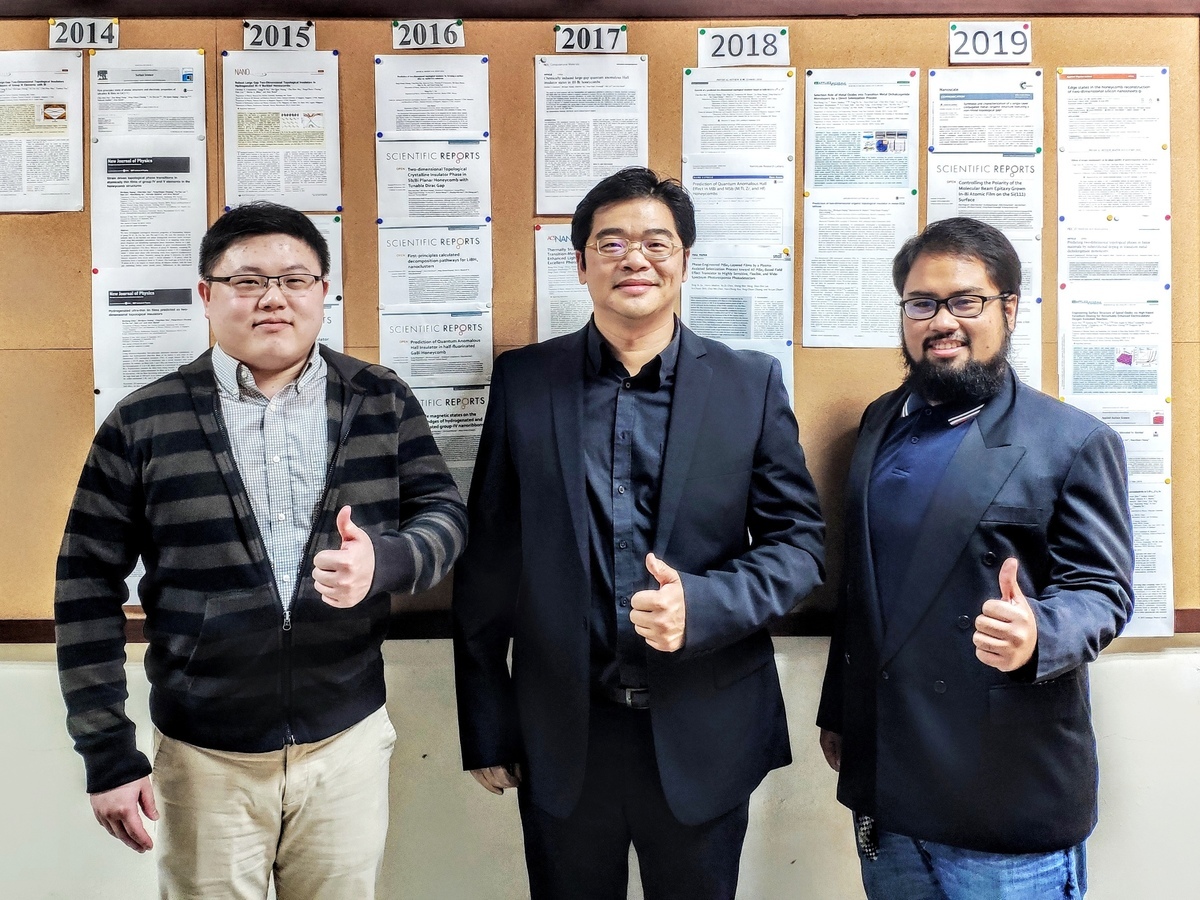Research result produced by international collaboration between Professor Feng-Chuan Chuang and Distinguished Chair Professor Tai-Chang Chiang published in Physical Review Letters


(Provided by NSYSU Department of Physics)
Professor Feng-Chuan Chuang of NSYSU Department of Physics, together with Professor Tai-Chang Chiang of the Department of Physics, University of Illinois at Urbana Champaign formed an internationally collaborative research team and published their research result on “Dimensionality-mediated semimetal-semiconductor transition in ultrathin PtTe2 films” in Physical Review Letters. Physical Review Letters is considered to be one of the most prestigious journals in the field of physics by many physicists and other scientists. This is the third research paper by Professor Chuang’s team published recently in one of the most prestigious journals, after a paper published in the same journal and another in Science Advances.
The team led by Professor Chuang includes Dr. Chia-Hsiu Hsu and PhD student Rovi Angelo B. Villaos originally from the Philippines, while the team of Professor Chiang of the Department of Physics, University of Illinois at Urbana Champaign includes Dr. Meng-Kai Lin and PhD Student Joseph A. Hlevyack. Professor Chiang is also a fellow of Academia Sinica and holds the title of Distinguished Chair Professor of NSYSU.
Professor Chuang pointed out that PtTe2 is a layered structure ruled by the van der Waals force and is also a new type-II Dirac semimetal. This material has already attracted a lot of interest from physicists. The research focused mainly on the changes in the physical properties of the different number of layers of ultrathin PtTe2 films from one to a few layers. The research team discovered that when the thickness of the layer reaches tri-atomic layers, semimetal material will change its state to become a semiconductor. Thanks to the calculations by Professor Chuang’s team based on density functional theory and the angle-resolved photoemission spectroscopy method applied by Professor Chiang’s team, the researchers could clearly study the electronic structure of two-dimensional materials. Hence, this could be of great help for investigating the basic properties, as well as the possible applications of the said material. That being so, what is more important, having chosen a layered material, is that the control of the transformation of its properties could be achieved.
“I am very happy and honored to know that another important research result of our laboratory was published in one of the top internationally-read journals for the third time in a row”, said Professor Chuang. He expressed his gratitude to the University for its support and efforts to promote internationalization; thanks to the joint effort of NSYSU President Ying-Yao Cheng, Vice President for Research and Development Mitch Chou, and Vice President for International Affairs Chih-Wen Kuo, NSYSU reached new milestones in international research cooperation and attracted more international talents. Professor Chuang also thanked the experimental team for diligently synthesizing the materials and measuring its properties. He also mentioned that thanks to the combination of theoretical calculations and experimental measurement, the basic properties and the related application of materials could be studied more in depth. Besides this, joining an international team not only fosters bilateral exchange but also helps students broaden their horizons and understand the focal research points of the leading teams of different fields. In the future, cooperative ties with different laboratory teams in Taiwan and abroad will be strengthened.
Besides investing in cooperation with international teams, starting from 2014, Professor Chuang temporarily held the post of department chair and actively attracted outstanding international students. Not only did he create a good foreign-language environment, but also helped improve students’ language abilities. The excellent performance of international students inspired a sense of competition in Taiwanese students. Now, the team of Professor Chuang is very internationalized – it includes members from Taiwan, the Philippines, India, Vietnam, Indonesia, Pakistan, and Sri Lanka. Lastly, he emphasized that active progress and investment of energy is the only way to successful research. He hopes that in the future the team will have even more, and even better research results published.
(Provided by Public Affairs Division)
Paper in Physical Review Letters:
https://journals.aps.org/prl/abstract/10.1103/PhysRevLett.124.036402
Professor Feng-Chuan Chuang of NSYSU Department of Physics, together with Professor Tai-Chang Chiang of the Department of Physics, University of Illinois at Urbana Champaign formed an internationally collaborative research team and published their research result on “Dimensionality-mediated semimetal-semiconductor transition in ultrathin PtTe2 films” in Physical Review Letters. Physical Review Letters is considered to be one of the most prestigious journals in the field of physics by many physicists and other scientists. This is the third research paper by Professor Chuang’s team published recently in one of the most prestigious journals, after a paper published in the same journal and another in Science Advances.
The team led by Professor Chuang includes Dr. Chia-Hsiu Hsu and PhD student Rovi Angelo B. Villaos originally from the Philippines, while the team of Professor Chiang of the Department of Physics, University of Illinois at Urbana Champaign includes Dr. Meng-Kai Lin and PhD Student Joseph A. Hlevyack. Professor Chiang is also a fellow of Academia Sinica and holds the title of Distinguished Chair Professor of NSYSU.
Professor Chuang pointed out that PtTe2 is a layered structure ruled by the van der Waals force and is also a new type-II Dirac semimetal. This material has already attracted a lot of interest from physicists. The research focused mainly on the changes in the physical properties of the different number of layers of ultrathin PtTe2 films from one to a few layers. The research team discovered that when the thickness of the layer reaches tri-atomic layers, semimetal material will change its state to become a semiconductor. Thanks to the calculations by Professor Chuang’s team based on density functional theory and the angle-resolved photoemission spectroscopy method applied by Professor Chiang’s team, the researchers could clearly study the electronic structure of two-dimensional materials. Hence, this could be of great help for investigating the basic properties, as well as the possible applications of the said material. That being so, what is more important, having chosen a layered material, is that the control of the transformation of its properties could be achieved.
“I am very happy and honored to know that another important research result of our laboratory was published in one of the top internationally-read journals for the third time in a row”, said Professor Chuang. He expressed his gratitude to the University for its support and efforts to promote internationalization; thanks to the joint effort of NSYSU President Ying-Yao Cheng, Vice President for Research and Development Mitch Chou, and Vice President for International Affairs Chih-Wen Kuo, NSYSU reached new milestones in international research cooperation and attracted more international talents. Professor Chuang also thanked the experimental team for diligently synthesizing the materials and measuring its properties. He also mentioned that thanks to the combination of theoretical calculations and experimental measurement, the basic properties and the related application of materials could be studied more in depth. Besides this, joining an international team not only fosters bilateral exchange but also helps students broaden their horizons and understand the focal research points of the leading teams of different fields. In the future, cooperative ties with different laboratory teams in Taiwan and abroad will be strengthened.
Besides investing in cooperation with international teams, starting from 2014, Professor Chuang temporarily held the post of department chair and actively attracted outstanding international students. Not only did he create a good foreign-language environment, but also helped improve students’ language abilities. The excellent performance of international students inspired a sense of competition in Taiwanese students. Now, the team of Professor Chuang is very internationalized – it includes members from Taiwan, the Philippines, India, Vietnam, Indonesia, Pakistan, and Sri Lanka. Lastly, he emphasized that active progress and investment of energy is the only way to successful research. He hopes that in the future the team will have even more, and even better research results published.
(Provided by Public Affairs Division)
Paper in Physical Review Letters:
https://journals.aps.org/prl/abstract/10.1103/PhysRevLett.124.036402
Click Num:
Share
